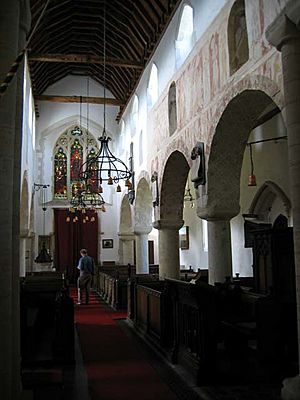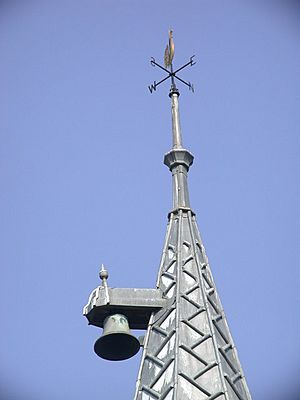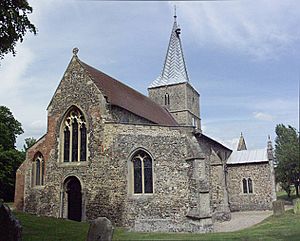St Mary Magdalene Church, Ickleton facts for kids
St Mary Magdalene Church is a special old church in the village of Ickleton, Cambridgeshire, England. It's a Church of England church, which means it's part of the main Christian church in England. This church is so important that it's a Grade I listed building. This means it's one of the most important historic buildings in the country. It shares its church duties with two other nearby churches: St Peter's in Duxford and SS Mary and John in Hinxton.
Contents
History of the Church
Building the Old Church
This church is named after St Mary Magdalene. It was built a very long time ago, in the late 1000s or early 1100s. This was during the Norman period in England. The builders used rough stones and flint for the walls. They also used special Barnack limestone for details.
The church was first dedicated to St Mary the Virgin. Later, it was rededicated to St Mary Magdalene. This was because she was the patron saint of Ickleton Priory, a nearby religious house. A famous historian, Nikolaus Pevsner, said the church's Norman inside is "far too little known." He thought it was one of the best in England.

The church was first built with a main hall called a nave. It also had a chancel (the area near the altar) and a tower in the middle. The nave had high windows, called a clerestory, to let in light. It also had a round-arched door at the west end. There were aisles (side passages) on both the north and south sides.
The nave had four round arches on each side, connecting it to the aisles. Some of the stone columns holding up these arches were very old. They were actually Roman columns, reused from an even older building! Other columns were Norman copies of these Roman ones. Most of these original Norman parts are still there today.
Ancient Wall Paintings
In the late 1100s, beautiful frescoes were painted inside the nave. Frescoes are paintings done on wet plaster. These paintings were in two rows above the arches. They showed four scenes from Christ's Passion. They also showed three paintings of saints being martyred. These saints were St Peter, St Andrew, and St Lawrence.
Changes Over Time
In the 1200s, the church was changed a bit. The arches under the central tower were made pointed. This was a new style called Early English Gothic. But the old Norman columns supporting them were kept. The church also has a south transept, which is like a side arm. We don't know exactly when it was built.
There used to be a north transept too, making the church shaped like a cross. But this part was taken down at some point. You can still see where its arch was blocked up. The arches on the north and south sides of the tower were added later, in the late 1200s or early 1300s.
Decorated Gothic Style
Many changes happened in the early 1300s, in a style called Decorated Gothic. The tower was made taller around 1340. New windows were put into the south transept. The arch connecting the transept to the south aisle was also rebuilt.
The south aisle itself was rebuilt and made wider. A special porch with a rib vaulted ceiling was added to the south side. The church's font, where baptisms happen, might also be from the 1300s. It has eight sides. The high windows (clerestory) in the nave were made even taller. A new roof was put on, and a broach spire (a tall, pointed roof) was added to the tower.
Some colorful glass from the 1300s can still be seen in the south aisle windows. Also from this time is a wall painting above the chancel arch. It shows the Doom, with Christ and the Virgin Mary. The church was rededicated in 1351. This might be when all these building changes were finished.
Perpendicular Gothic Additions
In the mid-1400s, more changes were made in the Perpendicular Gothic style. The chancel was rebuilt. A north chapel and a vestry (a room for clergy) were added. The west windows of the nave and north aisle were also changed to this style.
The church got new wooden furniture. This included a rood screen (a screen separating the nave from the chancel). It also got new pews (benches) and stalls (seats for the choir). The carved ends of two of the pews, called poppyheads, are still original. The church was rededicated again in 1452.
Later Repairs and Discoveries
In the 1700s, some parts of the church were rebuilt. By 1791, the north chapel, vestry, and north transept had been taken down. By 1877, the churchyard was too small for burials. So, in 1883, a new cemetery and funeral chapel were opened nearby. The chapel was built in a Gothic Revival style, looking like an old Early English church.
Between 1882 and 1885, the chancel was rebuilt again. The 15th-century piscina (a basin for washing sacred vessels) was kept. But new sedilia (seats for clergy) were added in the Gothic Revival style. In 1979, the roof of the south transept was damaged by fire. It has since been replaced.
It was during the cleaning work after this fire that the old 12th-century frescoes in the nave were found! They had been painted over for hundreds of years. This probably happened after the Reformation in the 1500s.

Church Bells
Early Bells
After Ickleton Priory was closed down, records show the church tower had three bells. In 1552, during the Edwardine Reformation, the church was recorded as having four bells. It also had a Sanctus bell. A Sanctus bell is a small bell rung during parts of the church service. By 1742, the tower had a ring of six bells. There were also two Sanctus bells placed unusually on the outside of the spire.
18th Century Bells
A lot of work was done on the bells in the 1700s. Thomas Newman, who made bells in Norwich and Cambridge, cast two of the bells in 1729. These are now the fourth and seventh bells. Thomas Lester from the Whitechapel Bell Foundry made the largest bell, called the tenor bell, in 1751. William Chapman, also from Whitechapel, cast what is now the fifth bell in 1781.
The Curfew Bell
By the late 1800s, only one Sanctus bell was left on the outside of the spire. It was made around 1500 by a bellmaker whose name is now unknown. This bell was used as a curfew bell, ringing at a certain time each evening. It was also used as a fire bell. Later, it was connected to the church clock to strike the hours.
Modern Bells
The six main bells were repaired in 1907. But within 20 years, their frame broke. The tenor bell fell and was damaged. In 1927, a company called Gillett & Johnston from Croydon recast all six bells. They also added two new bells, a treble and a second bell. This increased the total number of bells to eight.


